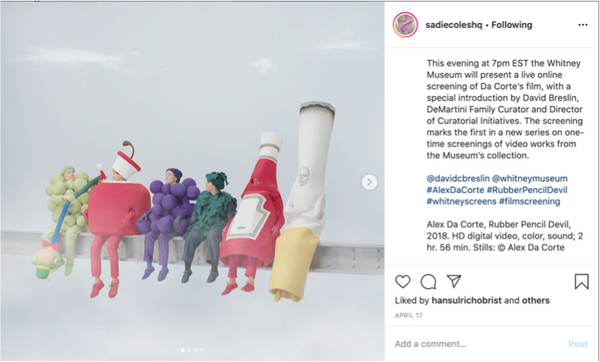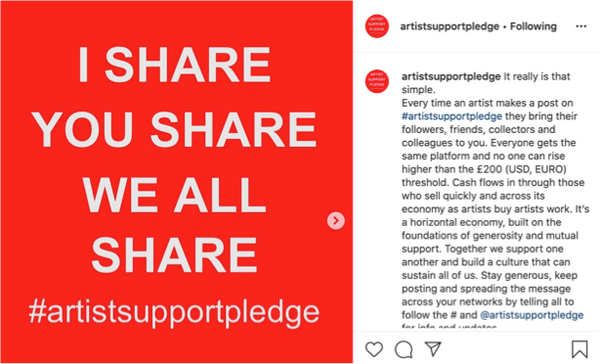Safety Net | Our realities become virtual as everything is uploaded with the best art now existing online
Posted by Kat Koch on

The sudden emergence and virulent occupation of the coronavirus across the globe has forced the art world as we know it to move online. It started with the cancellation of Art Basel Hong Kong in early February, swapping VIP tickets for logins to their online viewing rooms, then followed by the Sydney Biennale, which became the first international biennale to go online just 10 days after opening to the public. By now, all major and minor museums and art institutions alike have migrated to the online sphere. With lockdown extensions and further cancellations of events, our notion of a “place” for public gathering has unrecognisably transformed- it is now the internet. Content is sprouting in a rhizomatic manner on websites, online platforms, social media, and video communication sites- Zoom, Houseparty, TikTok, Twitch, Facebook chat, Facetime, WhatsApp video- are now part of the quotidian jargon and a necessity. The internet has become our lifeline, enabling connectivity and allowing us to continue operations. Technophobes and internet nay-sayers have had a baptism by fire over the last few weeks, as institutions scramble to upload content and social media teams work in overdrive to carve out a place in the digital world. We are inextricably linked to the internet, it seems that if we want to preserve our culture in the current moment, we need to upload it.
On a recent episode of Russell Tovey and Robert Diament’s brilliant podcast, Art Talk (Special QuARTine Episode), Canadian troubadour Rufus Wainwright recalls heatedly convincing a friend of his position that art, rather than money, is the most important thing in the world because ‘all that is left is the art in the end’. The Tate website has seen a 5,000% increase since the quarantine started with 15,000 artworks being uploaded over only 2 days, implying that Wainwright’s strongly held opinion on the importance of art is a widely-shared sentiment. Restricted especially as we currently are, we shouldn’t feel captive as hostages but rather free to engage with the online realm. In the B.P.era (Before Pandemic), internet artists, online galleries, and independents were utilising the internet out of choice, not necessity; whether it be as a financially viable alternative to the white-cube gallery space, a site of artistic medium, or institutional critique. Looking to these early adopters could provide answers to navigating life after the pandemic.
Wikipedia defines, “An art museum or art gallery [as] a building or space for the display of art.” In 2020 this is a restrictive, inaccurate, and outdated definition. What about Banner Repeater located on Platform 1 in Hackney Downs overground station, the nomadic Skip Gallery previously having hosted David Shrigley and Gavin Turk’s work, or the Laundromat Project organising exhibitions at laundrettes in NY, to name but a few. The individuals at the helm of these institutions would surely see their work constituting the same respect as an exhibition in a more formal setting does. It seems to be an issue of etymology rather than cultural relevance. Soft Opening in London transformed a public space into an exhibition venue, by converting an empty storefront in Piccadilly Circus tube station to a gallery. In 2018, after years of exhibiting nomadically without a space to call her own, Antonia Marsh found an opportunity in the challenge that underlies finding and financing a gallery space in London. Marsh muses, “People make a conscious choice to go into an art gallery, but, putting it in a tube station, everyone has to see it. It’s no longer a choice because it’s just there. […] this gives you the opportunity to communicate things to a wider audience.” The Laundromat Project is another endeavour that transforms a public space into that of cultural exchange. It has been running for 15 years conceiving exhibitions and events at laundrettes in multicultural neighbourhoods across New York, allowing artists to engage with their local communities in an “ordinary” location rather than the potentially alienating environment of a white-cube. The lack of affordable physical space to exhibit art is a recurring issue. Corvi-Mora and greengrassi, two South London based galleries, have spaces solely dedicated to the runnings of a gallery, but they happen to be in the same building; one upstairs, one downstairs, swapping over the exhibition space for each new show. Of course, they also collaborate on private views, welcoming visitors with homemade soup and beers to encourage post-viewing conversations. (Alas, when will we be able to go to a PRIVATE VIEW again?! *crying_emoji*). ArtNight London, run by creative duo Ksenia Zemtsova and Philippine Nguyen, is a free contemporary art festival, commissioning and premiering artworks by practising contemporary artists, in a programme held across various locations in London for one night only. The 2020 version has been postponed until 2021, with a list of featured artists being announced on Instagram, comprising the programme that will be based in and around Somerset House and the Southbank. It’s clear that art is by no means restricted to neither museums nor commercial galleries, where there is a will there is a way to show art, and so it should be no surprise that even in a pandemic creatives have used the means at their disposal to continue making their work visible and their voices heard.

While our physical bodies stay at home, our virtual avatars are allowed to roam as far and wide as our internet providers allow, and never has there been a more bountiful offering. Currently, commercial galleries such as Pace, Marian Goodman, Massimo di Carlo, and David Zwirner now cater for collectors with online viewing rooms. While institutions, like Tate Modern, the Royal Academy, and Goldsmith’s Centre for Contemporary Art opt for the more educational, interactive approach: a virtual (sometimes curator-led) tour of their current exhibitions. However, as art critic JJ Charlesworth remarks, these VR alternatives only hold their value for so long, because they are a mere facsimile of the real thing. Frith Street Gallery and East-London based Anna Kultys are offering new content every week; with their online programmes Frith Street Gallery at Home: A Moving Image Programme and Anna Kultys’ [The Art Happens Here]. International art publication Art Review’s Art Lovers Movie Club follows a similar model, showcasing artist films and digital works that have included Laure Prouvost and Wong Ping. With regards to performance art, intrinsically requiring audience presence, social media platforms like Instagram Live are having a moment. From 18-19th April TACO gallery (as Tracey-Aint-Coming-Out on Instagram) curated a performance weekend on Instagram Live, with Beth Kettle, Tom Smith, and Holly Pester. I watched the ‘event’ ‘together’ with my friends via Zoom, ending as every art festival should with a live DJ set. Simon Bayliss selected tunes streamed on RTM.fm, which on my part turned into a bedroom boogie. Similar to a television channel, Instagram Live takes its structure from scheduling, a certain programme is aired at a certain time for a specific amount of time, you have to “show up” to see it- this engenders a shared experience; the stuff of water-cooler conversations. The current demand for prolific online content is facilitated by platforms like Instagram Live, which is low-tech and easy to set up. All you really need to host an artist interview is two people with phones and an internet connection. König Galerie regularly uses this function for its #10amseries hosting interviews with artists, and friends of the galleries in Berlin, London, and Tokyo about artworks, exhibitions, and current topics.” Sadie Coles has connected with artists and curators, Alex da Corte, Maria Balshaw and Sarah Lucas, through her Instagram feed. In lieu of an exhibition pamphlet, Answers from Isolation is a series of posts featuring artists' responses to questions such as, “Do you foresee some changes in the art world after this crisis?” and requests like, “Artists are great foodies. Send us a comfort recipe.” Online exhibition visits, curator talks, performances, artist interviews, and even lectures continue all from the comfort of your home.


Art aficionados have been compensated for the closure of art spaces relatively quickly, but the fragile art ecosystem consists of a greater complexity of layers than merely the erecting and taking down of exhibitions. Artists rely on sales, which inevitably have decreased in the current climate, leading to a dissipation of artist revenue streams. One no-brainer way to support artists is to buy their work. Artist Matthew Burrows created the Artist Support Pledge in mid-March 2020 in response to artists fearing a loss of sales, in which creatives upload 5 of their artworks at £200 each with the binding pledge that whenever all 5 works have been sold they vow to buy 1 work by another artist. Artist and Activist Wolfgang Tillmans has initiated 2020 Solidarity, a campaign to support nightclubs, art, and music venues under threat due to the Covid-19 crisis, where posters designed by leading artists - Marlene Dumas, Andreas Gursky, and Tillmans himself - are offered for £50/$50/€50 apiece. This nominal donation amounts to what may be spent on a night out at one affected establishment. A-N, the artist membership site offers artist bursaries supporting artists, who may not be able to benefit from the government schemes. Anyone missing face-to-face tutorials or seeking creative support can contact East Side Projects based in Birmingham to arrange Zoom 1-to-1s. There is strength in numbers, and this pandemic has not initiated an insular every-man-for-themselves mentality, but rather inspired creative ways to use the internet positively.

Even the New Yorker has recently noticed how “nice” the internet has become since our banishment from the physical into the virtual realm. Mindless binge-streaming and vitriolic troll attacks seem to be a thing of the past, instead, the internet is allowing culture to continue. Exhibitions continue to be viewed, artists and curators’ voices heard, artworks sold, and tips on DIY creativity shared! The internet, as the apex of human technological achievement, has, over the initial weeks of lockdown, allowed us to maintain a semblance of normality; by keeping us connected under the threat of isolation. We are in a global pandemic, a terrible shared experience, but the uplifting, transformative, and cognitively regenerative characteristics inherent in culture are what truly binds us, not the fear nor the despair this virus has spread; and we are reminded of this by touching our screens and looking at the world (wide web).
by Kat Koch
Share this post
- 0 comment
- Tags: Art Basel Hong Kong, art gallery, art world, connected, covid19, Internet, Kat Koch, museum, online, online viewing rooms, safety net, Sydney Biennale, virtual reality, world wide web
